Evaluating America’s green energy options including astroelectricity (part 2)by Mike Snead
|
| The new green energy infrastructure must also be capable of producing green fuels because an all-electric energy infrastructure is unrealistic as it would lack robustness and resiliency in the face of severe weather and other severe energy demands. |
The general green energy transition model, shown in Figure 1, was introduced in Part 1. In this model, green electrical power generation sources become the primary source of energy replacing fossil fuels. This primary green electricity becomes the primary source of energy being used directly and also being used to produce green hydrogen and green carbon fuels. These green fuels—such as diesel and jet fuels—will then be used by the end users and will be used by utilities to generate dispatchable green electricity to fully meet seasonal and weather-related demands. With this approach, the general nature, safety, and convenience of today’s industrial energy infrastructure will be maintained as America fully transitions to green energy. Properly engineered, the changes will be largely transparent to the public meaning that no “great reset” to a lower standard of living need happen for America to go green.
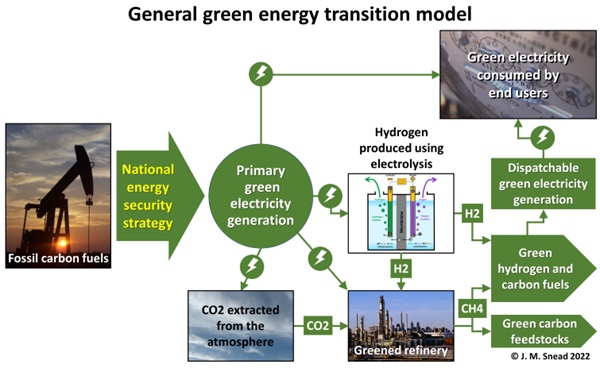 Figure 1 |
Two variations of this general model were also introduced in Part 1. The first used baseload power plants as the primary source of green electricity while the second used intermittent power sources. After excluding possible green energy sources that cannot practicably be scaled up to replace fossil carbon fuels—for example, hydroelectricity—the remaining four primary sources that are considered in this evaluation are shown in Figure 2. These are the baseload sources of nuclear fission power and space solar power and the intermittent sources of wind power and ground solar power.
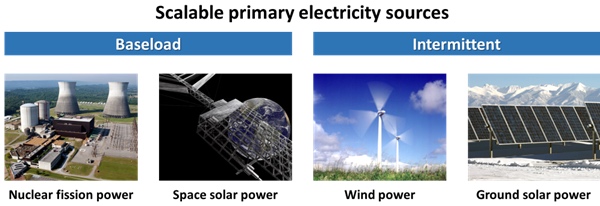 Figure 2 |
As shown in the transition model, the new green energy infrastructure must also be capable of producing green fuels because an all-electric energy infrastructure is unrealistic as it would lack robustness and resiliency in the face of severe weather and other severe energy demands. The two green fuels evaluated are hydrogen and methane. Green hydrogen is produced using electrolysis while green methane—a green carbon fuel—is produced by combining green hydrogen with carbon dioxide extracted from the atmosphere. This green methane along with other green carbon fuels (e.g., diesel and jet fuels) and green carbon industrial feedstocks will be produced at “greened” refineries. In this manner, the end users of green energy will receive electricity and fuels much as they do today with the difference being that they will be produced with little or no environmental impact. Properly engineered, this transition to green energy should be generally transparent to the public without the need for unpopular changes in lifestyle or reductions in the standard of living.
(Note: While the combustion of green carbon fuels will emit carbon dioxide into the atmosphere, there will be no net addition since carbon dioxide is extracted from the atmosphere to manufacture the green carbon fuels.)
When the four possible primary green electricity sources are combined with the two types of fuels, this yields eight cases to be quantitatively evaluated. These are shown in Table 1.
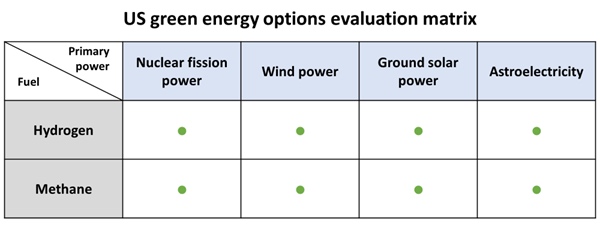 Table 1 |
What would it have taken for America to have gone green in 2020?
As especially seen in California, many politicians are trying to nibble away at making America green. Constantly, new financial incentives (e.g., to encourage buying an electric car) or restrictions—such as to only being able to buy an electric car—are being adopted in the hope that somehow these will rapidly end America’s use of fossil carbon fuels. Reasonable people understand that such disjointed, often foolish, approaches will not succeed. Apparently blind to the substantial engineering challenges America faces in transitioning to green energy in an orderly manner, too many politicians simply grab on to whatever new green idea comes along.
Engineers understand that the appropriate first step is to gain a “mountain top” view of the challenges America faces in transitioning to green energy. Therefore, Part 2 begins by estimating what it would have taken the United States and, for comparison, the European Union (EU) to have already gone green by 2020. (Note: The EU values do not include Britain.)
Per person energy use in 2019 used as the baseline
In 2020, the world began to experience a pandemic that resulted in a substantial reduction in economic activity and, consequently, energy use. For this reason, the per person energy consumption from 2019, the year prior to the start of the pandemic, is used to estimate the replacement green energy needed per person in 2020. This per-person equivalent green energy use will then be multiplied the US 2020 national census resident population to estimate the total green energy America would have needed in 2020. This is then repeated for the EU.
First: A brief review of electrical power and energy
As discussed earlier, with the transition to green energy, the primary energy source will become electricity. Therefore, a brief review of electrical power and electrical energy is appropriate.
| Apparently blind to the substantial engineering challenges America faces in transitioning to green energy in an orderly manner, too many politicians simply grab on to whatever new green idea comes along. |
The unit of electrical power is the watt (W). A kilowatt (kW) equals 1000 watts. A gigawatt (GW) equals 1 billion watts or 1 million kW. For perspective, a typical LED light bulb will use about 10 W of power, while a typical countertop microwave oven will use about 1 kW. A typical large nuclear power plant will generate around 1 GW of power. This is enough power to run 1 million microwave ovens—enabling 1,000,000 people to make microwave popcorn at the same time on a movie night.
Electrical energy is how much electrical power is used over a period of time. If a microwave oven operates for one hour, it will use 1 kilowatt-hour (kWh) of electrical energy. For each hour that a nuclear power plant runs, it generates 1 gigawatt-hour (GWh) of electrical energy.
The key point to understand is that electrical power is measured instantaneously while electrical energy always has a time component—usually an hour or a year. While baseload power sources are generally described in terms of their rated or “nameplate” electrical power, intermittent sources are best described in terms of the total electrical energy produced in a year. Describing intermittent sources using their nameplate power rating is often very misleading—perhaps, intentionally so—because they do not generate this power continuously.
Later in Part 2, a different representation of electrical energy is also used. This is called the “equivalent continuous power”. Imagine that the 1-kW microwave oven operates continuously for one year—for 365 × 24 = 8,760 hours. It would use 1 kW × 8,760 hours = 8,760 kWh of electrical energy. Thus, each 8,760 kWh of electrical energy used equates to 1 kW of equivalent continuous power used. Just as the barrel of oil equivalent (BOE) unit helps to visualize an amount of thermal energy a person uses, each kW of equivalent continuous power can be thought of as an amount of electrical energy a person uses. (Note: This equivalent continuous power is expressed as kilowatts-continuous, abbreviated as “kWc”.)
US and EU per person green energy needs in 2019
With America’s still strong dependence on fossil carbon fuels, the US government uses the BOE energy unit to report energy statistics. As the name implies, a BOE equates to the thermal energy available in a 42-US gallon barrel of oil. The use of a physical representation of the amount of energy helps in understanding how much energy is now being used.
As shown in Figure 3, the average American used 52.7 BOE of total energy in 2019. This total reflects the energy used directly, such as for home heating and personal transportation, as well as the energy used to supply the goods and services consumed. For comparison, that same year, the average European used only 22.3 BOE—only 42% of what Americans used—reflecting their different style of living.
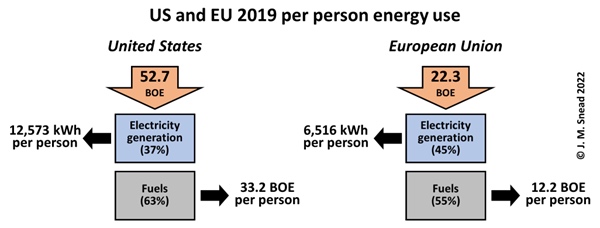 Figure 3 |
As discussed in Part 1, America is blessed with substantial fossil fuel resources that have been and are still being used to economically strengthen America and, especially, to increase America’s middle-class prosperity. For perspective, American per person energy use last equaled the current EU use around 1900—120 years ago—just as the age of motorized personal transportation was beginning.
Figure 3 also shows the breakdown of this total energy use in terms of the electricity and fuels used. For example, in America, 37 percent of the total energy consumed was used to supply electricity while in the EU this was 45 percent.
US 2019 equivalent green energy use per person
In 2019, on average, each American used 12,573 kWh of electrical energy and 33.2 BOE of combustible fuels. Using the baseload and intermittent green energy models shown in Part 1, the amount of primary baseload or intermittent green electrical energy needed to yield 12,573 kWh of dispatched green electricity and 33.2 BOE of green fuel can be estimated. A total of four estimates are made: baseload primary power with either hydrogen or methane as the fuel and intermittent primary power with either hydrogen or methane as the fuel. The author’s estimates of these results are shown in Table 2.
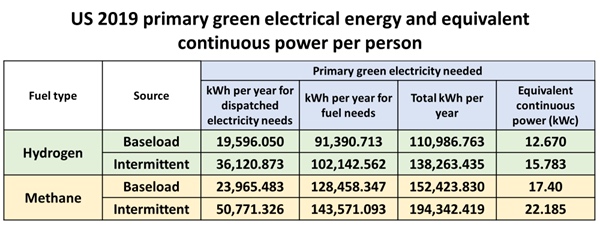 Table 2 |
For example, when using the baseload-hydrogen transition model, 19,596 kWh of primary baseload power would need to be supplied to enable a utility to reliably dispatch 12,573 kWh of electrical power to the end user. The difference is the additional primary power needed to produce the hydrogen used by utilities to fuel the gas turbine generators used to meet seasonal and other peak electricity demands. This hydrogen would replace the natural gas now used for this purpose.
In preparing the Table 2 estimates, available US Department of Energy and industry information on hydrogen electrolysis and carbon dioxide extraction from the atmosphere was used. To produce green hydrogen using electrolysis, each BOE of hydrogen (lower heating value) is estimated to require 2,615 kWh of primary green electrical energy. For perspective, a typical home uses 1000 kWh a month when not using air conditioning or electric heating.
The chemical formula for methane is CH4, meaning that each methane molecule has one carbon atom and four hydrogen atoms. Thus, hydrogen must first be made using electrolysis and then chemically combined with carbon dioxide extracted from the atmosphere to produce green methane synthetically. Since both steps require primary green electricity, the total amount of primary green electrical energy needed to produce each BOE of green methane (lower heating value) increases to an estimated 3,676 kWh. Producing each BOE of methane requires about 40% more input primary green electrical energy than does each BOE of hydrogen.
In Table 2, also note the differences between the baseload and intermittent cases for each of the two fuels. This is due to how the use of primary baseload and primary intermittent power is handled in the respective green energy transition models. For an orderly transition to green energy, the variability of such intermittent primary sources must be addressed to ensure that end users are reliably supplied with high-quality electrical power sufficient to meet the demand. As explained in Part 1, accommodating this intermittency increases the total input primary electrical power needed per person.
US 2019 per person equivalent continuous power need
In Table 2, the far column shows the total energy needed for each of the four cases expressed in terms of the equivalent continuous power. For the baseload-hydrogen case, this would require 12.67 kWc to have gone green in 2019. This can be thought of as roughly equaling the power to run 13 countertop microwave ovens continuously. For the intermittent-methane case, this increases to 22.185 kWc, enough to run 22 microwave ovens continuously for each American. The increase is due to using intermittent power and the fact that it takes more green electricity to manufacture each BOE of methane compared to hydrogen.
| To have gone green by 2020, the United States would have needed an equivalent continuous electrical power generation capacity equal to between 2,091 and 3,661 Hoover Dams, depending on the primary power source. |
Recall that a typical American home uses about 1,000 kWh per month or 12,000 kWh per year. This yields an equivalent continuous electrical power demand of 12,000 ÷ 365 ÷ 24 = 1.4 kWc per home. Compare this to the intermittent-methane total need for 22.185 kWc per person. For a family of four, nearly 90 kWc would have been needed to have gone green in 2019. This comparison provides an indication of why “going green” cannot happen quickly.
EU 2019 green energy needs per person
Table 3 shows the corresponding values for the EU in 2019. As expected, the EU would have needed much less primary green electrical power per person to have gone green in 2020.
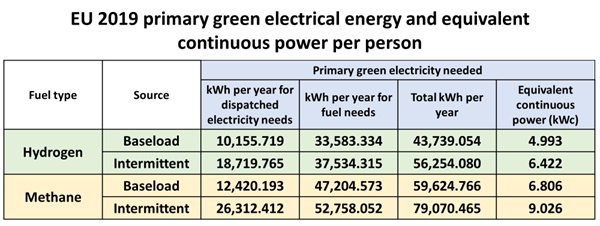 Table 3 |
US national green energy needed to have gone green in 2020
Using the per person kWc values in Table 2, the total green energy needed for America to have gone green in 2020 can be estimated by multiplying that by the 2020 population.
Now, we will use a little engineering units conversion trick to easily convert the Table 2 equivalent continuous electrical power values, expressed in kWc, into the corresponding national equivalent continuous electrical power values expressed in GW. (Note: This equivalent continuous power is expressed as gigawatts-continuous, abbreviated as “GWc”.)
To start, we will start with an assumed per person use of 1 kWc. For a population of 1 million people, the total equivalent continuous power needed becomes 1,000,000 kWc. For calculating the total national green energy needs, the kW unit is too small. Noting that 1 gigawatt (GW) = 1,000,000 kW, the national results are best expressed using the GWc unit. Thus, each 1 kWc per person in Table 2 requires 1 GWc for each one million people in the total population.
In 2020, the US census population was 330 million while the EU population was 450 million. Applying this conversion trick yields the national values shown in Table 4. For example, recall that the US baseload-hydrogen case value in Table 2 was 12.67 kWc. Applying the trick for a US 2020 population of 330 million yields a total national need for 12.67 × 330 = 4,181 GWc.
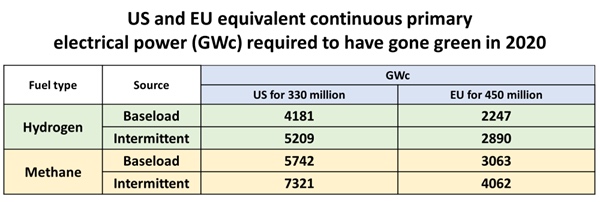 Table 4 |
Expressing green energy needs in terms of the Hoover Dam
Just as the microwave oven provides an understandable representation of 1 kW, the Hoover Dam will be used to represent GW-scale power needs. The Hoover Dam has a nameplate generation capacity of around 2 GW. Thus, each 2 GW of green equivalent continuous power needed equals one Hoover Dam, ideally operating continuously. Using this “unit”, the US and EU equivalent number of Hoover Dams needed to have ideally gone green in 2020 is shown in Table 5.
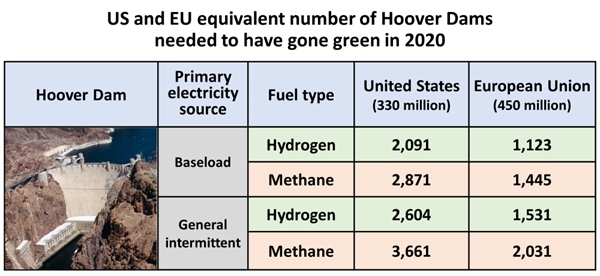 Table 5 |
To have gone green by 2020, the United States would have needed an equivalent continuous electrical power generation capacity equal to between 2,091 and 3,661 Hoover Dams, depending on the primary power source. For comparison, the European Union would have needed between 1,123 and 2,031 Hoover Dams. The substantial magnitude of the effort needed to go green, pragmatically, is why the year 2100 is used in this assessment as the target year to complete America’s transition to green energy. These results also indicate that many politicians seeking to rapidly end the use of fossil fuels apparently are not aware of—or have chosen to ignore—the scale of the new green energy infrastructure needed to enable this transition to be completed.
(Note: While reviewing these US results, keep in mind that with continued net international migration to the United States, as will be discussed in Part 3, the US population will likely grow 50% by 2100. This will, obviously, proportionally increase the values for the US shown in Table 5. Each additional one million migrants will add the need for, at least, six additional Hoover Dams of continuous generation capacity.)
California and New York green energy needs
California and New York have taken state leadership positions in the political drive to “go green”. Through legislative and regulatory means, they wish to lead America’s rapid transition to green energy. Using the methodology used to prepare Table 4, comparable estimates of the total green energy needed for each of these two states to have gone green can be made.
| A substantial expansion of nuclear fission power will not yield a practicable approach to enabling America to end the use of fossil carbon fuels. |
The latest state energy use statistics available are for 2015. In that year, with a population of 39 million, California used 34 BOE of total energy per person. For New York, with a population of 20 million, 33 BOE of total energy was used per person. In 2015, the overall US per person energy use was 52.3 BOE—very close to the 2019 value of 52.7 BOE used in calculating the Table 4 estimates. (Note: The warmer climate in California and the high urban population of the New York City metropolitan area likely account for their per person total energy use being significantly less than the US average.)
With adjustments made for each state’s per person total energy use, the ballpark estimates of the equivalent continuous electrical power needed to have gone green in 2015 are shown in Table 6. California would have needed the equivalent of 159–279 Hoover Dams (318–557 GWc) while New York, with a smaller population, would have needed 77–135 Hoover Dams (154–270 GWc). California and New York would have needed a total per person supply of 8–14 kWc. These results help to understand the gap that exists between fervent state environmental idealism and the engineering reality of what it really takes for these two states to go green.
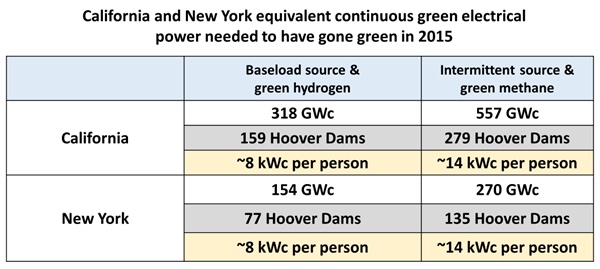 Table 6 |
Dismissing nuclear fission power as an American green energy option
Nuclear fission power was included as one of the two baseload options for this assessment. Currently, there are well-funded efforts underway to reinvigorate the US nuclear industry, which has been struggling for several decades because of legacy gigawatt-scale nuclear power plants that are costly to operate and raise public concerns about their safety. However, for reasons discussed in the following, the author believes that a substantial expansion of nuclear fission power will not yield a practicable approach to enabling America to end the use of fossil carbon fuels.
The proposed use of modular nuclear fission reactors
One “new” approach gaining public attention is the proposed use of smaller nuclear fission reactors. Intended to be built on assembly lines and installed at a powerplant’s location, these smaller reactors are referred to as “modular”. (See Figure 4.) A goal of this approach is to decrease the construction cost and time for building nuclear power plants. While this approach may have merit for reducing costs, all other concerns arising with the use of nuclear fission power appear to remain.
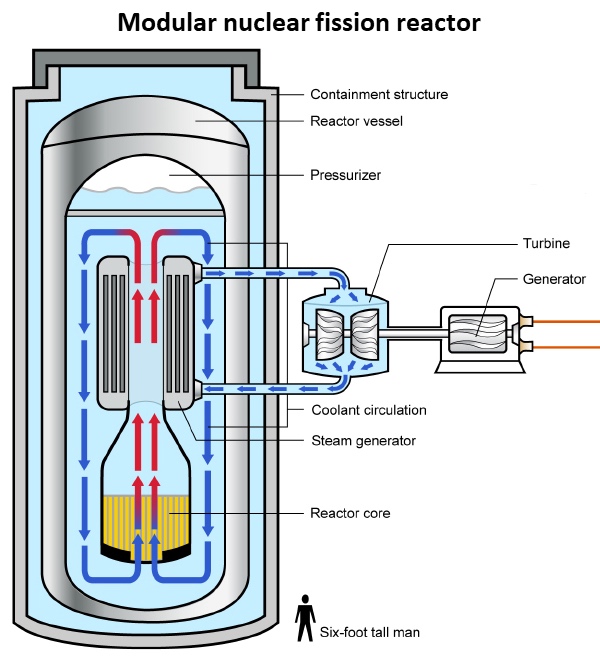 Figure 4 |
These modular reactors could produce up to 0.33 GW or 330 megawatts (MW) each. For perspective, the US Navy’s nuclear-powered Nimitz-class aircraft carriers use two 550-MW reactors. For this discussion, a modular reactor producing 0.25 GW or 250 MW of power is assumed.
Waste heat rejection must be considered
A typical full-scale nuclear fission power reactor can produce about 1 GW of electrical power. In the process, it also produces about 3 GW of unusable (waste) heat that must be rejected to the local environment surrounding the nuclear power plant. This cooling is usually done using river, lake, or ocean water as the waste heat dump. This is not a problem unique to nuclear reactors. All thermal sources of electricity generation—such as coal-fueled power plants—must dump waste heat into the local environment.
For nuclear power reactors—whether full-scale or modular—the waste heat disposal issue arises when trying to scale up the total nuclear generation capacity to substantially replace fossil carbon fuels. The total magnitude of the waste heat needing to be handled must be considered when determining where nuclear fission power plants can be built. For perspective, just California and New York, respectively, would have needed approximately 318 and 154 1-GW class reactors in 2015. Where in these two states could this number of nuclear power plants be located to enable the waste heat to be rejected into the local environment in an environmentally acceptable manner?
The need for nuclear fuel breeding will likely enable nuclear weapon proliferation
Nuclear fission reactors require fissionable fuel to operate. Within the reactor, the nucleus of the nuclear fuel atoms fission—break apart—forming the nuclei of lower atomic weight elements. As this fissioning happens, a very small portion of the mass of the original nucleus spontaneously converts into energy, hence the name “nuclear energy”. Also, as a fuel atom’s nucleus fissions, two to three free neutrons emerge. Quickly, these free neutrons become captured in the nuclei of nearby atoms. When this happens to another fuel atom’s nuclei, it becomes unstable and fissions, creating a continuous chain reaction that sustains the release of nuclear energy within the reactor. Within the reactor, this energy turns into heat that is used to generate electrical power.
| It is worth noting that after a half-century of commercial nuclear power plant operations, no politically acceptable means of permanently storing the highly radioactive nuclear waste has been identified. |
Of all the possible naturally occurring elements found on the Earth and their thousands of isotopes, only one—the U-235 uranium isotope—can be used as a fissionable fuel in a conventional nuclear reactor. However, the world’s limited supply of minable natural uranium means that minable U-235 is incapable of supporting a substantial expansion of nuclear fission power.
During World War II, when the supply of U-235 needed to build atomic bombs was limited, the technology to artificially transmute other elements into fissionable isotopes was developed. This is done inside a nuclear reactor using the released free neutrons to trigger the transmutation. (Note: Transmutation is a complex series of changes in the composition of the nucleus that results in the nucleus spontaneously changing from one element to another.) In this manner, the fissionable Pu-239 plutonium and U-233 isotopes were bred.
Like U-235, both of these fissionable isotopes can be used to make nuclear weapons. One of the first two nuclear weapons used in World War II used plutonium. In 1955, the US tested a weapon design that used U-233, showing that not only could U-233 be used to make a weapon but that the highly radioactive U-233 could be handled safely while making the weapon’s explosive core.
In an attempt to prevent nuclear weapon proliferation, the US ended the breeding of plutonium in 1987 and stopped breeding U-233 when supplies of U-235 increased in the 1950s. It takes only about 10 kilograms of these isotopes to make a nuclear weapon. If the United States were to restart breeding to produce Pu-239 and U-233 fuels for nuclear power plants, other nations will likely do the same. Obviously, this would increase the risk of nuclear weapon proliferation using covert methods to divert the production of Pu-239 and U-233 to nuclear weapon uses.
Nuclear fuel breeding needs
The World Nuclear Association stated that each GW-year of operation of a nuclear power plant requires about 1,400 kg of fissionable U-235. It is assumed that the amount of U-233 and Pu-239 needed per GW-year would be about the same.
As shown in Table 7, had the US converted entirely to nuclear power in 2020—simplistically assuming the plants operate continuously—the United States would have needed 4,181 of the full-scale 1-GW reactors or 16,724 of the modular 0.25-GW reactors. These would generate around 12,500 GW of waste heat, needing to be disposed into the local environment, and would require that around six million kilograms of nuclear fuel be bred each year. The comparable results for the European Union are also shown in Table 7.
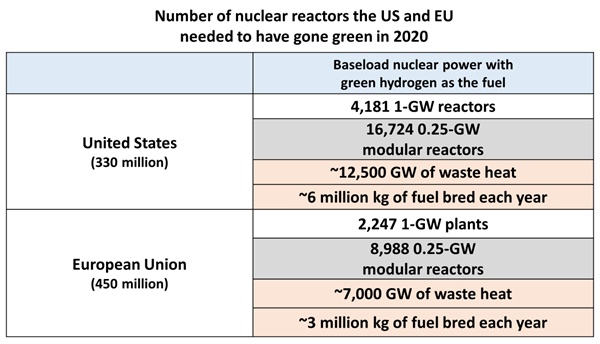 Table 7 |
Additional scale-up issues with nuclear fission power
In addition to the waste heat disposal and nuclear weapon proliferation considerations, a host of other important considerations arise that must be technologically addressed and/or politically resolved prior to proceeding with a substantial expansion of nuclear fission power. These include safety risks involving human or naturally caused accidents (e.g., the 2011 Japanese nuclear accidents), security from terrorist or military attacks (e.g., the 2022 Russian attacks near Ukraine nuclear power plants), electromagnetic pulse attacks, nuclear fuel breeding scale-up challenges, and the need for permanent nuclear waste disposal. Regarding disposal, it is worth noting that after a half-century of commercial nuclear power plant operations, no politically acceptable means of permanently storing the highly radioactive nuclear waste has been identified.
Scaling up nuclear fission power is an unwise and unlikely option for America
While there may be sound energy policy reasons to replace the current aging nuclear power plants with more advanced, safer designs using U-235 as part of an orderly transition to green energy, it is both unlikely and unwise to plan to scale up nuclear fission power to substantially replace fossil carbon fuels. Hence, nuclear fission power is excluded in this assessment as a practicable option for America to go green.
Key points of Part 2
- For Americans to have already gone green, each American would need a primary green electrical power supply sufficient to run 13–22 1-kW countertop microwave ovens continuously.
- For America to have already gone green, America would need the equivalent of between 2,091–3,661 2-GW Hoover Dams operating continuously.
- Scaling up nuclear fission power as a primary means of replacing fossil carbon fuels is unwise and unlikely.
- The substantial scale of America’s needed new green energy infrastructure indicates that this will likely take most of the rest of the century to build.
What’s ahead in part 3
With nuclear fission power falling from consideration, this leaves terrestrial renewables and space solar power-generated astroelectricity as the remaining possible means for America to successfully go green. While we know that wind and ground solar power can be used to generate green electricity, many politicians simply assume that these can be readily scaled up to enable America to fully transition to green energy. For example, Figure 5 is a map of the contiguous US showing where, in the blue areas of the map, commercial wind farms could be built. Would building wind farms on nearly two-thirds of the country enable America to go green by 2100 while keeping America energy secure and prosperous?
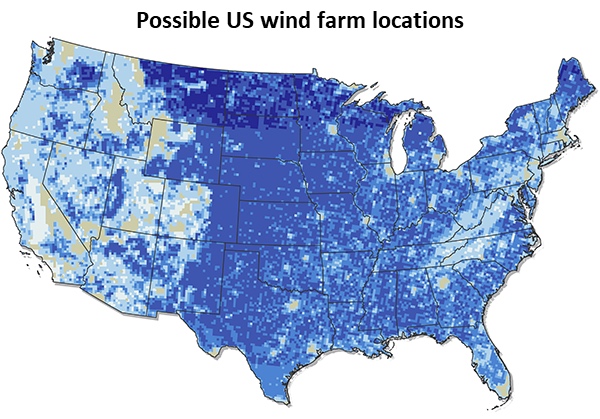 Figure 5 |
Part 3 will quantitatively examine wind and ground solar power to see if these would enable America to practicably go green by 2100. These results will indicate whether America is now on the correct path for becoming a sustainable and prosperous nation or whether a dramatic change of course will be needed with America undertaking the spacefaring industrial revolution needed to develop space solar power.
Author’s note
The quantitative information presented in this article is provided for information purposes only and is not intended to be used for any other purposes. The author believes that the information provided is accurate, consistent with the top-level nature of these analyses and the sources of information used.
Note: we are using a new commenting system, which may require you to create a new account.
